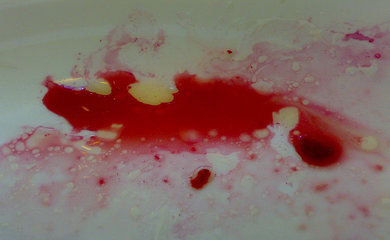When it comes to Bryan Fuller, I have come to expect a certain kind of television. Hypersaturated colours, dream-like settings, quirky and enduring characters, a hint of darkness; his television is like a glass of classically tart lemonade, all glittering perfection with just a bit of bite in it to keep you on your toes. His projects have also all been tragically short-lived. Pushing Daisies and Wonderfalls are perhaps among his best known, and they flamed out early despite having that classic Fuller charm, making me think that perhaps it didn’t appeal to general audiences.
If you come to Hannibal (NBC), Fuller’s latest project, expecting the usual, think again. Remember: This is a show about Hannibal Lecter. The show represents a total 180 from his previous work, illustrating that Fuller has incredible depth of range that apparently remained hidden before. It’s dark, moody, angry, ultraviolent, and extremely creepy. At the same time, it’s stunningly beautiful and thrillingly detailed.
Starring Mads Mikkelsen in the title role opposite Hugh Dancy as Special Agent Will Graham, Hannibal is splattering television scenes with gore, making some important strides with network audiences, and gathering buzz. It’s gained one of the few spots on my must-watch list every week, which sets it well above most network television at any time of year, but especially in the late spring/early summer, when networks typically put out their most dismal fare.
Hannibal, a narrative about the early life and times of Hannibal Lecter, is breaking all kinds of boundaries. Unlike most television aired at this time of the year, it’s dark, intellectual, and thrilling; a far cry from the usual summer fluff, and a bold move for NBC. Furthermore, the show is presented in a 13 episode format and will continue to be (Hannibal just picked up an order for a second season). Fuller remains committed to this presentation because it offers so much to creators.
He, like other network producers and creative talent, is starting to look more closely at the cable model, taking some lessons away from it to see what works effectively. And one of the best things about cable is the short seasons, which force tight arcs, neat storytelling, and elegant explorations of characters without room for filler episodes. Hannibal is, if you will forgive the pun, much meatier than your typical network series.
And it’s also much, much gorier. This is not a show for the faint of heart, given that it features gruesome deaths on a weekly basis with a fairly large side of cannibalism. At the same time these deaths are horrific, some of them are also strangely compelling; the sculpture made out of dead bodies in ‘Trou Normand’ was oddly beautiful, presented as a work of art as much as it was evidence of a serial killer who had been working over the course of decades.
Artistically, Hannibal stands out with a very distinctive design, editing style, and presentation; a hallmark signature of Fuller’s productions, but with a very different look and feel than Fuller’s presented in the past. The very fact that Hannibal has what amounts to an artistic personality, however, distinguishes it from other network shows; the creative team have dared to actually engage in art direction, careful (and sometimes wry) set dressing, and the brilliant construction of personalities through costumes, sets, scenery, the props the characters use.
The food, too, is beautifully styled, becoming its own character without distracting from the drama. That’s appropriate, given the looming role the food occupies in the minds of viewers, who of course know the entirety of the story that the characters do not; we approach Hannibal knowing who Hannibal is, who he and Will Graham will become. This is not a series about the destination, which is already predetermined, but instead the journey the characters take to get there.
With occasional cameos from old faces in the Fullerverse (including Caroline Dhavernas of Wonderfalls as Dr. Alana Bloom), Hannibal manages to regularly remind sharp-eyed viewers of Fuller’s previous works while also setting itself apart from them. Fuller’s lack of fear when it came to a dramatic departure from his usual ouvre has proved successful in terms of compelling (and horrifying) audiences, and yet these reminders also anchor us to some of the core themes that keep coming up in Fuller’s television shows.
Death, of course, is the most obvious; Dead Like Me revolved entirely around death, dying, and processing life after death. Likewise, Pushing Daisies probed at the barriers between life and death and the consequences for becoming, in essence, a living dead girl. But Fuller’s shows also have a history of exploring family relationships and intimacy in the face of absurd, terrifying, and bizarre circumstances, and I’m hoping we see some of this in Hannibal, as it’s one of the things Fuller does best.
This is our opportunity to learn even more about Hannibal Lecter, about his strange budding relationship with Will Graham, who is friend, colleague, research subject, client, and something else not quite definable. This, too, is our chance to see a young Will Graham collaborating with Lecter without realising who, or perhaps what he is collaborating with. As we see the tight ties of their relationship wind around them, it’s obvious that neither man can emerge from this meeting of minds unscathed, and that what they do with each other will shape them for the rest of their lives.
Even cannibalistic serial killers, after all, need backstories.
Photo by Stella Dauer of beetroot blood, licensed under a Creative Commons Attribution-ShareAlike 2.0 Generic (CC BY-SA 2.0) license.

